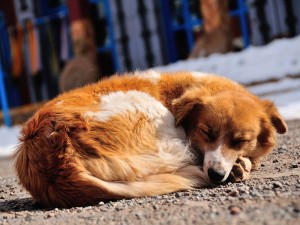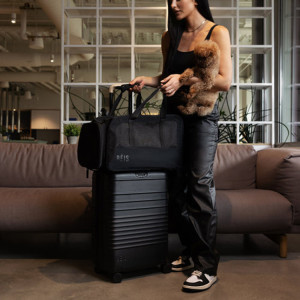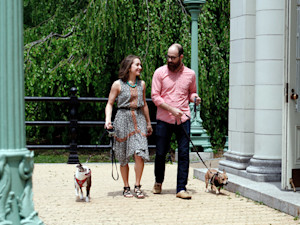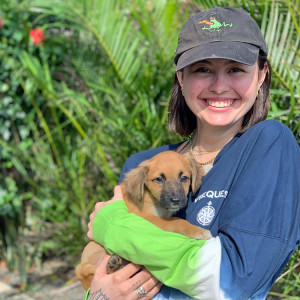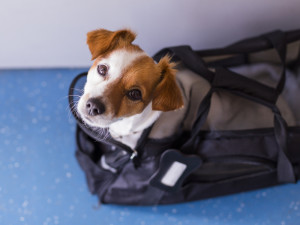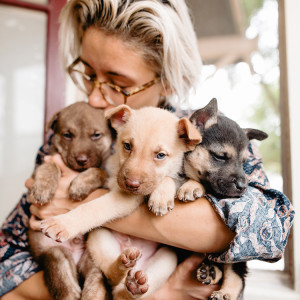Want to Help a Rescue Pet Get to Their New Home? Become a Transport Volunteer
Domestic and international transport volunteers are in high demand—here’s how you can become one.
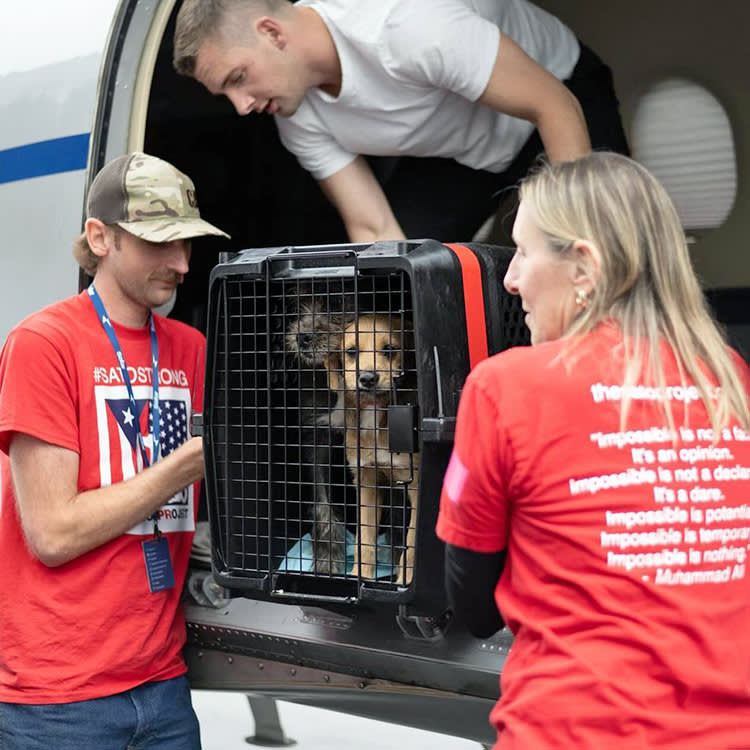
Share Article
Ever wonder how dogs rescued from hurricane-ravaged islands or overcrowded shelters make it to their new homes safely? You. Or, at least, it could be, if you became a transport volunteer. And it’s a lot easier than you might think.
Rescue organizations on both sides of the trip coordinate with each other and handle all the logistics. Your job is simply to show up and make the journey.
How international transport works
Say you are planning a trip to Korea (or Morocco, Puerto Rico, Thailand, Turkey — anywhere with a large population of strays, a high animal-control kill rate, or a life-threatening industry like dog meat production). Reach out to a rescue in the area you are visiting. Just do a Google search for “animal rescue flight volunteer” and your destination. Chances are, if there is a need, you’ll find it.
Let them know about your expected travel plans (dates, route, etc.) and that you are willing to add an animal to your return trip. Not all airlines allow animal transport, so if you let the rescue know before you buy your ticket, they may be able to suggest one that does.
How much do you spend on your pet per year?

If you’ve already bought your ticket, the rescue may need you to call the airline and add an animal. There is always an additional fee associated with transporting an animal, but the rescue should cover this on the travel day when their representative arrives with the animal. And if you need to pay it in advance, they should reimburse you.
The rest of the logistics — paperwork, transport to and from the airport, reservations, etc. — should be taken care of by the rescue at no cost to you. They should also provide you with contact information — phone numbers and emails — of the organizations and individuals you will be meeting at each end of your journey.
On the day of your flight, someone from the rescue should meet you at the airport with a crate and the animal ready to travel, having been walked, peed, and pooped before arriving. The crate should have a pee pad, some water, and something soft, like a towel. The rescue liaison should then review the travel plan with you one last time, hand over any paperwork you might need for the trip, and stay with you until the animal is checked in.
If you are taking a direct flight, you will probably not see the animal again until you arrive at baggage claim. If the animal is small enough, you might travel with them in the cabin, in which case it’s a good idea to ask the rescue for some treats/food, a small bowl, extra pee pads, and some wipes in the event of an accident.
If for some reason you need to take the animal out of their carrier at any time during the flight, make sure to do so in the lavatory with the door locked and the toilet seat lid down. You do not want the animal escaping into the cabin or falling into the open toilet.
If your travel plans include a layover, you may be able to take your animal out of their crate in a designated pet relief area. Research in advance if the airport has such an area and discuss your plans with the rescue first as you will probably need a leash, collar, extra wee wee pads, and fresh zip ties to re-secure the crate, if necessary.
When you arrive at your final destination, proceed through passport check, and, if the animal traveled in the airplane’s cargo hold, pick them up at baggage claim before moving on to customs. Whoever is receiving the animal should meet you just beyond customs, at which point you will make the handoff and your job will be done.
How to help with domestic transport
No international travel plans? Domestic travel volunteers are in high demand as well. All you need is a valid driver’s license, a clean record, and a love of the open road. You may not even need your own car as the larger domestic rescues that coordinate such transports, like Potter Leagueopens in new tab in Middletown, Rhode Island, often have their own vehicles expressly for the purpose.
When Potter League transports animals, it is often an effort to help relieve overcrowding in municipal shelters in neighboring states. Unlike with the international rescue travel described above, this sort of domestic travel often involves driving dozens of animals across state lines at once.
“What transport does is try to balance supply and demand, getting animals that might not have much of a chance in one community to a place where they are more likely to get adopted,” says Potter League CEO Brad Shear.
Potter League transports around 800 animals per year and schedules their transports up to a year in advance. They coordinate with the sending shelter and send out two volunteer drivers per van to pick up the animals and bring them back to Rhode Island.
It’s a complicated process on their end, but straightforward for their volunteer transporters. They simply load up the van, consulting their paperwork as they go, give the animals a quick visual check to make sure they are safe to travel, and then hit the road. Depending on the length of the trip, there might be a stop or two for walks or water or to address any medical issues, but the truck is fully air-conditioned, and most trips go off without a hitch.
When the animals arrive, staff and volunteers unload them and then take the truck out back to give it a thorough cleaning. “It’s an incredibly important job,” Shear says. “But you have to understand that you will not get a lot of time with the animals, so you need to be satisfied knowing you are having an impact without actually spending the day interacting with the animals directly. You can’t take them out of their crates to cuddle or drive with them on your lap. You have to see the bigger picture and know that what you’re doing really is helping.”
Kathy Jacobs, programs coordinator at Friends of the Animal Shelteropens in new tab in Aiken, South Carolina, a nonprofit 501(c)(3) organization dedicated to supplementing the work of the overburdened Aiken County Animal Shelter (ACAS), adds that her org “would would have to euthanize almost half of the animals that come through our doors if we didn’t have a transfer program.”
ACAS took in over 4,700 dogs and cats last year, according to Jacobs, and even now they are forced to divide each of their kennels in half to accommodate all of their new summer arrivals. “We are so overwhelmed right now,” says Jacobs, who has worked with Potter League for over a decade to help transport animals to less crowded counties. “We could never sustain our no-kill status if we didn't have transfer partners to save so many.”
Transport volunteering isn't just for long distances, though. Many shelters and rescues are in need of people willing to transport animals to and from foster homes and veterinary appointments, especially if you have your own car. They may even reimburse you for gas.
Whatever type of transport volunteering you decide to do, the crucial thing to keep in mind is reliability. Shear and his team at Potter League often start prospective transport volunteers closer to home — helping out at the rescue or walking dogs — until they’ve proven themselves. Given the complex coordination required to make a transport work — not to mention the number of animals whose lives hang in the balance — there’s no room for flakiness. Not that you’d ever do that. You know what’s at stake.
International rescue transport organizations (just to name a few):
China: Little China Dog Rescue
Costa Rica: Charlie’s Angels Rescue
Korea: Korean K9 Rescue
Mexico: Wet Noses Rescue
Morocco: Morocco Animal Aid
Puerto Rico: Sato Project and Flight Angels
Thailand: Soi Dog
Turkey: Tattered Paws and Golden Hearts Rescue

Charles Manning
Charles Manning is an actor and writer based in New York City. In his free time he likes to cook, go swimming at the public pool, volunteer at the LGBTQ senior center, and foster senior and special-needs cats. His work has previously appeared in Cosmopolitan, Elle, Marie Claire, Harper’s Bazaar, Seventeen, and Nylon.
Related articles
![anonymous woman pampering and taking care about a small ginger kitten]()
6 Ways to Help Local Shelters Without Committing to Full-Time Pet Parenthood
Learn how you can be there for animals in need this National Pet Day.
![Dog sitting in a dog carrier]()
6 Expert Tips to Make Flying With Your Dog as Smooth as Possible
Plus, a few products to seal the deal.
![a person with short blonde hair and glasses hugs three rescue puppies and kisses one on the head]()
Where Have All the Fosters Gone?
This is the Paula Cole parody that rescue orgs are singing as they struggle to find people to foster pets.
![]()
How Korean K9 Gives Dogs Rescued From the Meat Trade a Second Shot at Life
The rescue’s founder, Gina Boehler, on her mission to help these pups start over.
